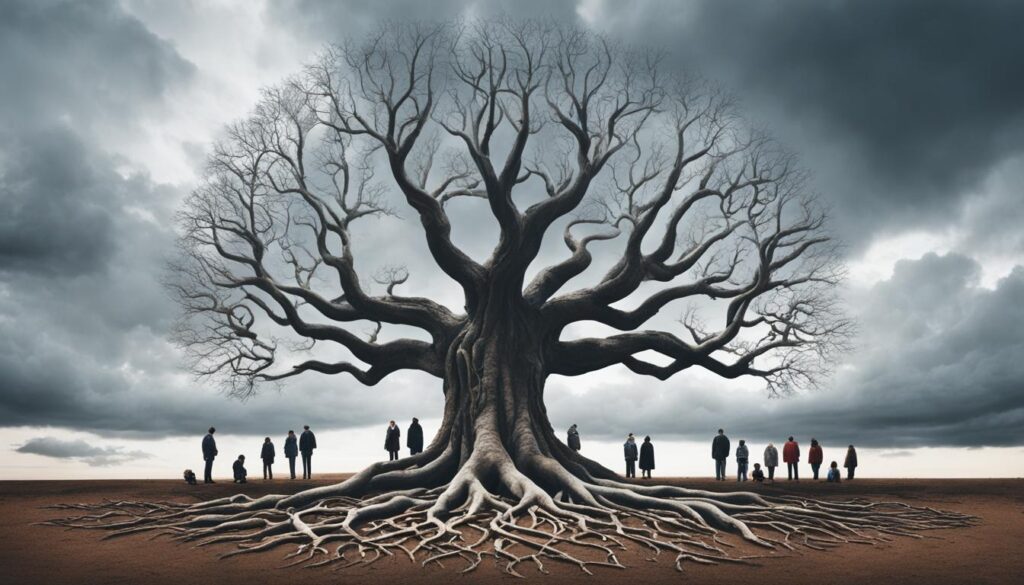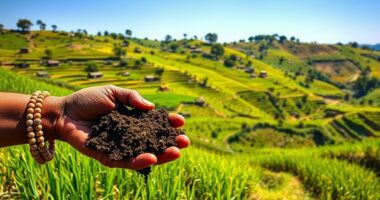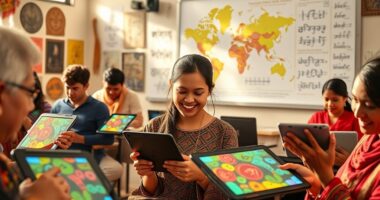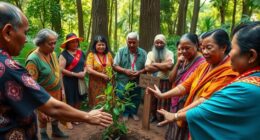Welcome to our Indigenous Languages Directory, a comprehensive collection that celebrates the various linguistic traditions of Australia’s Indigenous communities. With over 250 languages and 800 dialects spoken across the country, it is crucial to support language preservation and revitalization efforts. This directory allows you to discover the diversity and abundance of Indigenous languages, interact with native speakers, access language resources, and contribute to the protection of Indigenous heritage.
Key Takeaways:
- The Indigenous Languages Directory is a valuable resource for discovering and learning about Indigenous languages in Australia.
- By connecting with native speakers and accessing language resources, you can contribute to the preservation and revitalization of Indigenous languages.
- Language preservation is essential for maintaining cultural heritage and celebrating the diversity of Indigenous cultures.
- Supporting language education initiatives and programs helps to strengthen cultural identity and improve educational outcomes for Indigenous students.
- Through the Indigenous Languages Directory, we can all play a role in ensuring that Indigenous languages continue to thrive for future generations.
The Importance of Language Preservation
Indigenous languages are not just a means of communication, but they are also a key aspect of our cultural identity and heritage. Language carries important knowledge passed down from our ancestors and elders, guiding us in our way of life. Unfortunately, many Indigenous languages are endangered, facing the risk of being lost forever.
Historical factors, such as government policies and the forced assimilation of Aboriginal and Torres Strait Islander peoples, have contributed to the endangerment of these languages. This threatens the linguistic diversity that is crucial for the richness of our cultural tapestry.
Language preservation efforts are of paramount importance. They play a crucial role in documenting and revitalizing endangered languages, ensuring that they continue to thrive for future generations. By preserving our languages, we ensure the continuation of our unique cultural heritage and traditions.
“Languages are the repositories of our culture, our way of life. They hold the key to our identity, our history, our stories. They are our connection to our land and to each other. We must fight to keep them alive.”
Language preservation involves various activities, such as:
- Language documentation: Recording and archiving the vocabulary, grammar, and cultural knowledge embedded in Indigenous languages.
- Language advocacy: Raising awareness about the importance of linguistic diversity and supporting policies that protect and promote Indigenous languages.
- Endangered languages support: Providing resources, funding, and educational programs to revitalization efforts.
Through these efforts, we can ensure that our Indigenous languages receive the recognition, support, and investment they deserve. The preservation of our languages is not just about words and grammar—it’s about preserving our cultural identity and strengthening our communities.
The Diversity of Indigenous Languages
Australia is home to a diverse range of Indigenous languages, with more than 250 languages and 800 dialects spoken across the country. Each language is specific to a particular place and people, reflecting the unique cultural heritage of different Indigenous communities.
In some regions, such as Arnhem Land, there is a high linguistic diversity, with many different languages spoken in a small area. This rich tapestry of languages is a testament to the incredible linguistic heritage of the Indigenous peoples.
In other regions, like the Western Desert, different dialects of the same language are spoken, illustrating the dynamic nature of Indigenous languages and their ability to adapt and evolve within different cultural contexts.
Understanding the diversity of Indigenous languages is essential for appreciating the rich cultural tapestry of Australia’s First Nations peoples. The Indigenous Languages Directory serves as a comprehensive database of native languages, providing a valuable resource for language preservation and learning.
Indigenous Languages in Arnhem Land
Arnhem Land in the Northern Territory is a region known for its linguistic diversity. It is estimated that over 40 different Indigenous languages are spoken in this relatively small area. Furthermore, many of these languages have multiple dialects, further highlighting the incredible linguistic richness of the region.
The following table showcases some of the Indigenous languages spoken in Arnhem Land:
| Language | Language Family |
|---|---|
| Djinang | Yolŋu Matha |
| Kuninjku | Gunwinyguan |
| Ritharrŋu | Yolŋu Matha |
| Yolŋu Sign Language | Village Sign |
These languages, along with many others not listed here, represent the unique cultural heritage of the Indigenous communities in Arnhem Land.
Distinct Dialects in the Western Desert
The Western Desert, spanning across Western Australia, South Australia, and the Northern Territory, is another region with fascinating linguistic diversity. While the languages spoken in this region are often part of the Pama-Nyungan language family, there are distinct dialects within each language.
The following table highlights some of the different dialects within the Western Desert language group:
| Language | Dialects |
|---|---|
| Pitjantjatjara | Pitjantjatjara, Pitjantjatjara Yankunytjatjara, Pitjantjatjara Ngaanyatjarra |
| Ngaanyatjarra | Pitjantjatjara Yankunytjatjara, Pitjantjatjara Ngaanyatjarra |
| Yankunytjatjara | Pitjantjatjara Yankunytjatjara |
These distinct dialects reflect the cultural and geographical variations within the Western Desert region, further emphasizing the importance of understanding the nuances of Indigenous languages.
Language and Identity
Language is a powerful tool that goes beyond mere communication. It serves as a reflection of cultural heritage, an expression of cultural pride, and a crucial element in shaping individual and community identity. For Indigenous communities, language holds immense significance, connecting them to their roots, traditions, and ancestors. Language revitalization efforts play a vital role in empowering native language speakers and ensuring the preservation of tribal languages. As part of these efforts, the Indigenous Languages Directory serves as a central resource center and community platform, supporting tribal language preservation initiatives and providing a space for native speakers to share and celebrate their languages with the wider community.
“Language holds immense significance, connecting indigenous communities to their roots, traditions, and ancestors.”
Reviving Endangered Languages
Historical government policies and the dislocation of Indigenous communities have had a devastating impact on the transmission of Indigenous languages. In many communities, the link between generations of language speakers has been broken, leading to the loss of knowledge and fluency in traditional languages. However, efforts are underway to revive endangered languages. By drawing on the memories of elders, historical records, and community engagement, languages that were once dormant are being recovered and revitalized.
The Indigenous Languages Directory supports language revival programs and provides a platform for communities to document and preserve their traditional languages.
Preserving Heritage Through Language
“Our languages are more than just words. They carry our stories, our songs, our history. They are our connection to the land and our ancestors. Reviving our endangered languages is an act of cultural renaissance, a way to honor our past and empower our future generations.”
In our efforts to revitalize endangered languages, we recognize the importance of documenting and preserving linguistic heritage. The Indigenous Languages Directory serves as a repository of language resources, providing a comprehensive database for researchers, linguists, and community members.
Supporting Language Revitalization Programs
We believe that language revitalization is a collective effort. Language revival programs play a crucial role in restoring endangered languages, promoting intergenerational language transmission, and fostering community pride and identity.
The Indigenous Languages Directory supports these programs by connecting language learners, educators, and native speakers. Through our platform, communities can share their language resources, collaborate on language documentation projects, and access valuable tools for language revitalization.
Documenting and Preserving Traditional Languages
As we strive to revive endangered languages, documentation becomes essential. Language documentation involves capturing linguistic features and cultural knowledge, creating a comprehensive record for future generations.
“Language documentation is like preserving a piece of our cultural puzzle. It allows us to piece together our traditions, our customs, and our unique ways of understanding the world. It is a way of ensuring that our languages never truly disappear.”
The Indigenous Languages Directory provides a platform for communities to document and preserve their traditional languages. Through our collaborative efforts, we can safeguard linguistic diversity, celebrate cultural heritage, and ensure the longevity of Indigenous languages.
The Power of Language in Education
At the heart of cultural preservation and academic success lies language education. Research has consistently shown that children who are taught in their first language, especially during the early developmental years, experience improved educational outcomes. This is especially true for Aboriginal and Torres Strait Islander students.
Indigenous language education plays a vital role in preserving cultural identity and heritage. By providing opportunities for students to learn in both their Indigenous language and English, language learning programs, such as bilingual education, offer a holistic approach to education that fosters cultural pride and academic achievements.
At the Indigenous Languages Directory, we recognize the power of language in education. We connect education institutions, dedicated educators, and eager language learners with valuable resources and materials, ensuring ongoing support for language education and cultural preservation.
The Benefits of Language Education
Language learning programs have profound effects on students and communities. By teaching Indigenous languages in schools, we enable students to:
- Develop a stronger sense of cultural identity and pride
- Build a deeper understanding of their heritage
- Boost academic achievements and language skills
- Promote intergenerational language transmission
Through language education, we empower young individuals to embrace their culture, connect with their ancestors, and preserve Indigenous languages for future generations.
Building a Brighter Future
We believe that language education is more than just a tool for communication; it is a means to cultural preservation and a bridge to a brighter future. By investing in language learning programs and supporting cultural preservation initiatives, we ensure the continuity of Indigenous languages and the vibrant tapestry of Australian cultural heritage.
“Language education is not just about words; it is about fostering a sense of belonging, empowering students, and preserving our rich cultural diversity.”
– [Educator Name]
| Benefits of Language Education | Language Learning Programs |
|---|---|
| 1. Enhanced cultural identity | 1. Bilingual education |
| 2. Academic achievements | 2. Language immersion programs |
| 3. Preserved heritage | 3. Language revitalization initiatives |
| 4. Stronger language skills | 4. Language resource centers |
By prioritizing language education, we build a society that values and preserves its diverse cultural tapestry. Together, let’s embrace the power of language in education and make a lasting impact on the lives of Aboriginal and Torres Strait Islander students.
The Tragedy of Lost Languages
The loss of Indigenous languages is a tragedy that is often overlooked. Through colonization and the impact of white settlement, many Aboriginal and Torres Strait Islander languages have vanished, taking with them an entire cultural universe. It is estimated that up to 90% of the world’s languages may disappear by the end of this century. Efforts to preserve and revitalize endangered languages are essential to prevent the loss of cultural diversity and ensure the continuation of Indigenous knowledge and traditions.
“Language is the carrier of our traditions, our customs, our values. It defines who we are as a people.”
Colonization has had a profound impact on Indigenous cultures and languages. As contact with European settlers increased, Indigenous communities faced immense pressure to abandon their languages and adopt the dominant language of the colonizers. This resulted in a devastating loss of cultural identity and heritage, as language is intricately woven into every aspect of Indigenous life.
The extinction of a language represents more than the loss of words; it erases a unique worldview, cultural practices, and systems of knowledge passed down through generations. With each language that disappears, a significant piece of humanity’s collective wisdom vanishes as well.
Language revitalization efforts are crucial for reclaiming and preserving Indigenous languages. These initiatives aim to reconnect communities with their ancestral tongues, reviving cultural practices, and fostering a strong sense of identity. By revitalizing languages, we can restore cultural pride and empower future generations to connect with their heritage.
| Impact of Language Extinction | Language Revitalization Efforts | Importance for Cultural Preservation |
|---|---|---|
|
|
|
The Indigenous Languages Directory serves as a vital resource for language revitalization efforts, providing a platform for community collaboration, access to language learning materials, and connections with native speakers. Through these collective efforts, we can work together to ensure the survival and safeguarding of Indigenous languages for generations to come.

Language Programs in Schools
The NSW Department of Education is committed to promoting the learning and teaching of Aboriginal Languages in NSW public schools. These Aboriginal language programs are designed to preserve, teach, and utilize local Indigenous languages, providing students with a deeper understanding of Aboriginal culture and enhancing their sense of identity.
By actively participating in these language programs, students have the opportunity to engage with and appreciate the rich cultural heritage of the Aboriginal communities in their region. Learning Indigenous languages not only fosters linguistic skills but also builds a stronger connection to the traditions, customs, and values of the Aboriginal people.
Through language learning, students develop a deeper respect for diversity and intercultural understanding. It allows them to gain insights into the experiences and perspectives of Aboriginal Australians, promoting empathy, tolerance, and a greater appreciation for cultural diversity.
The Benefits of Aboriginal Language Programs
Participating in Aboriginal language programs in schools brings numerous benefits to both students and the wider community:
- Preserving Cultural Heritage: Aboriginal language programs play a crucial role in safeguarding and revitalizing Indigenous languages, thereby preserving an essential part of Australia’s cultural heritage.
- Identity Building: Language is a vital component of cultural identity. By learning Indigenous languages, students strengthen their connection to their Aboriginal roots and build a stronger sense of self.
- Enhancing Academic Performance: Research has shown that language learning positively impacts overall academic performance, including cognitive skills, linguistic proficiency, and problem-solving abilities.
- Promoting Social Inclusion: Engaging with Aboriginal languages fosters a sense of belonging and inclusivity among Aboriginal and non-Aboriginal students alike, creating a more harmonious and understanding school environment.
- Fostering Intergenerational Connection: Aboriginal language programs provide opportunities for students to learn directly from native speakers and cultural knowledge holders, forging valuable intergenerational connections and facilitating the transmission of traditional knowledge.
By supporting Aboriginal language programs in schools, we are not only investing in the education of our students but also contributing to the preservation of Australia’s diverse linguistic landscape and cultural heritage.
Aboriginal Language and Culture Nests
Aboriginal Language and Culture Nests are community-based initiatives that offer a unique opportunity for students in NSW public schools to learn local Aboriginal Languages and cultural practices. These Nests are located in various regional language areas across the state, aiming to strengthen Aboriginal identity, pride, and community resilience. By increasing the number of language learners and teachers, these Nests play a vital role in the preservation and revitalization of Indigenous languages.
At the Indigenous Languages Directory, we recognize the significance of Aboriginal Language and Culture Nests as language preservation initiatives. We collaborate closely with these Nests, providing valuable support and resources for teaching and learning Indigenous languages in educational settings. Through our collaboration, we aim to foster community collaboration, celebrate cultural practices, and ensure the continuity and growth of language nests for future generations.
These Nests serve as hubs for cultural exchange, where students can immerse themselves in the language and traditions of their local Indigenous communities. Through interactive activities, language lessons, and engaging cultural experiences, students develop a deeper understanding of Aboriginal languages and their connection to cultural heritage. The Nests also provide opportunities for language learners to collaborate with community members, language teachers, and elders, further enriching the learning experience.
By creating a supportive environment and promoting community collaboration, Aboriginal Language and Culture Nests empower students to embrace their Aboriginal identity, fostering a sense of pride and belonging. The Nests not only contribute to language preservation but also play a crucial role in strengthening cultural knowledge, community relationships, and intergenerational connections.
Through our partnership with Aboriginal Language and Culture Nests, the Indigenous Languages Directory embarks on a shared journey of language preservation, cultural practices, and community collaboration. By providing access to educational resources, connecting language learners and teachers, and supporting the growth of language nests, we contribute to the preservation and revitalization of Indigenous languages for generations to come.
Aboriginal Language and Culture Officers
Aboriginal Language and Culture Officers (ALACOs) are integral to the development and implementation of quality Aboriginal language programs within the Aboriginal Language and Culture Nests. Our team of dedicated officers collaborates closely with schools, local language speakers, the NSW AECG (Aboriginal Education Consultative Group), and community reference groups. Through our collective efforts, we aim to ensure the success of language programs and the preservation of cultural knowledge.
At ALACOs, we understand the importance of community collaboration in promoting the revitalization and preservation of Indigenous languages. By working closely with various stakeholders, we create a strong network of support for language program development. Our partnership with schools allows us to integrate language learning into the curriculum effectively. We also collaborate with local language speakers, who possess valuable insights and expertise, ensuring the authenticity and accuracy of language teaching and learning.
In collaboration with the NSW AECG and community reference groups, we harness the collective wisdom and cultural knowledge of community elders and language custodians. This collaborative approach is central to our work, as it ensures that language programs are tailored to the specific needs and aspirations of each community, respecting and strengthening cultural connections and identity.
The Indigenous Languages Directory recognizes the vital role of ALACOs in promoting Indigenous language preservation and revitalization. Through our partnership, we provide support and recognition for the important work undertaken by ALACOs across Australia. Together, we strive to preserve and celebrate the rich linguistic diversity and cultural heritage of Aboriginal and Torres Strait Islander peoples.
Mission Statement
“By collaborating with schools, local language speakers, the NSW AECG, and community reference groups, our mission is to promote Indigenous language preservation and revitalization through effective program development and community engagement.”
Key Responsibilities
- Collaborating with schools to integrate Indigenous language learning into the curriculum
- Working closely with local language speakers to ensure the authenticity and accuracy of language teaching and learning
- Collaborating with the NSW AECG and community reference groups to incorporate community aspirations and cultural knowledge into language program development
- Providing guidance and support to language teachers and educators
- Advocating for Indigenous language preservation and revitalization within the education system
Meet Our Team
| Name | Role | Contact |
|---|---|---|
| Emily Johnson | Senior ALACO | emily.johnson@alacos.org |
| Michael Brown | ALACO | michael.brown@alacos.org |
| Sarah Wilson | ALACO | sarah.wilson@alacos.org |

NESA and Aboriginal Language Education
The NSW Education Standards Authority (NESA) is a key partner in supporting the teaching and learning of Aboriginal Languages in NSW public schools. We work collaboratively with educators, stakeholders, and community members to ensure that Aboriginal Language education receives the necessary attention and support it deserves. NESA’s commitment to Aboriginal Language education is reflected in our curriculum development, language syllabus, language assessment, and adherence to educational standards.
As part of our efforts to preserve and promote Indigenous languages, NESA develops Aboriginal Language syllabuses that provide a framework for teaching and learning in Aboriginal Languages. These syllabuses serve as comprehensive guides for educators, outlining the knowledge, skills, and understanding students are expected to gain throughout their language learning journey.
“Aboriginal Language syllabuses play a crucial role in preserving and revitalizing Indigenous languages. They provide a roadmap for educators, empowering them to deliver quality language education and to inspire a passion for language learning in their students.” – [Quote]
Through these syllabuses, NESA ensures that educators have clear guidelines for planning, programming, and delivering Aboriginal Language lessons that align with the goals and objectives of Indigenous language education. The syllabuses also promote culturally responsive teaching practices, fostering a deeper connection between students and their cultural heritage.
Language assessment is another important aspect of Aboriginal Language education guided by NESA. We provide guidance and resources for assessing student learning and progress in Aboriginal Languages. By establishing assessment criteria and performance standards, we ensure that language learning outcomes are effectively and consistently evaluated across schools.
“Language assessment allows us to gauge students’ language proficiency and development. It provides a comprehensive understanding of students’ linguistic abilities and helps us identify areas for improvement and intervention.” – [Quote]
At NESA, we are dedicated to upholding rigorous educational standards to ensure the quality and effectiveness of Aboriginal Language education. We collaborate with language educators, cultural knowledge holders, and community representatives to review and refine these standards, allowing for ongoing improvement and alignment with best practices in Indigenous language education.
NESA’s Contributions to Aboriginal Language Education
| Contribution | Description |
|---|---|
| Curriculum Development | NESA develops comprehensive Aboriginal Language syllabuses that guide language teaching and learning in NSW public schools. |
| Language Syllabus | NESA’s Aboriginal Language syllabuses provide a framework for educators, outlining learning objectives, content, and progression of language proficiency. |
| Language Assessment | NESA provides guidance and resources for assessing student learning and progress in Aboriginal Languages, ensuring consistent and effective evaluation practices. |
| Educational Standards | NESA upholds rigorous educational standards for Aboriginal Language education, ensuring the quality and effectiveness of language programs. |
At the Indigenous Languages Directory, we work in synergy with NESA’s initiatives, providing supplementary resources, materials, and connections to language learners and educators. Together, we aim to empower and support the teaching and learning of Aboriginal Languages in NSW public schools, preserving and revitalizing Indigenous languages for generations to come.
Community Language Programs
Beyond the Aboriginal Language and Culture Nests, the NSW Department of Education is dedicated to implementing community language initiatives that promote the learning and preservation of Aboriginal languages. These programs aim to enhance cultural awareness and knowledge within communities, develop valuable resources for adult learners, and establish systems that encourage the longevity of local languages. At the forefront of this effort is the Indigenous Languages Directory, which provides essential support for these community language programs.
The Indigenous Languages Directory serves as a comprehensive resource hub, offering access to a wide range of language materials, fostering connections between community members, and promoting cultural awareness. By providing a central platform for language learning and engagement, the directory supports the revitalization of local languages and strengthens the bonds within communities.
“The community language programs have been instrumental in promoting the value of our Aboriginal languages and preserving our cultural heritage. Through these initiatives, our communities are reclaiming their language and ensuring that future generations can connect with their traditions and identity.” – Dr. Jane Simmons, Language Program Coordinator
In addition to resources and connections, the Indigenous Languages Directory facilitates community collaboration and knowledge-sharing. It encourages community members, language speakers, and educators to come together, share their expertise, and collaborate on language preservation efforts. This collaborative approach fosters a sense of ownership within the community and empowers individuals to actively participate in the revitalization of their local languages.
Cultural awareness is a key component of community language initiatives. By engaging community members in language learning and preservation, these programs help to create a deeper appreciation for the cultural heritage associated with the language. Through the Indigenous Languages Directory, individuals can access resources that promote cultural awareness, including traditional stories, songs, and cultural practices, allowing for a more holistic and immersive language learning experience.
Overall, community language programs supported by the Indigenous Languages Directory are crucial in revitalizing and preserving local languages. By promoting cultural awareness, fostering community connections, and providing essential resources, these initiatives ensure the continued growth and revitalization of Aboriginal languages in communities across Australia.
Conclusion
The Indigenous Languages Directory is a valuable tool that enables us to explore and learn about Australia’s rich heritage of indigenous languages. By connecting language learners, educators, and native speakers, the directory supports ongoing language preservation efforts and revitalization initiatives. Through the preservation of indigenous languages, we have the opportunity to celebrate the cultural richness and diversity of Indigenous communities, while also strengthening cultural identity and ensuring that these languages continue to thrive for future generations.
The Indigenous Languages Directory serves as a testament to the resilience and importance of indigenous languages in maintaining our cultural heritage. It provides a central platform for individuals to access language resources, connect with native speakers, and actively participate in language revitalization. By actively engaging in language preservation, we can safeguard the invaluable knowledge and traditions embedded in these languages, and contribute to the overall preservation of Indigenous culture and identity.
Language revitalization is a vital component of preserving cultural heritage. The Indigenous Languages Directory serves as a digital hub that empowers language learners, educators, and communities to come together and ensure the survival of indigenous languages. By utilizing this platform, we can celebrate and value the significant contributions that indigenous languages bring to our cultural diversity, knowledge systems, and collective identity as Australians.
FAQ
What is the Indigenous Languages Directory?
The Indigenous Languages Directory is a comprehensive resource that allows users to explore and learn about Australia’s Indigenous languages. It connects users with native speakers, provides access to language resources, and supports the preservation of Indigenous culture.
Why is language preservation important?
Language preservation is important because Indigenous languages are not only a means of communication but also a key aspect of cultural identity and heritage. Language carries important knowledge passed down from ancestors and elders, guiding communities in their way of life.
How diverse are Indigenous languages in Australia?
Australia is home to over 250 Indigenous languages and 800 dialects. Each language is specific to a particular place and people, reflecting the unique cultural heritage of different Indigenous communities.
How does language contribute to identity?
Language plays a vital role in shaping individual and community identity. It is more than just a means of communication; it is a reflection of cultural heritage and a source of cultural pride.
What efforts are made to revive endangered languages?
Efforts to revive endangered languages include drawing on the memories of elders, historical records, and community engagement. Through language revitalization programs, languages that were once dormant are being recovered and revitalized.
How does language education support cultural preservation?
Language education, such as bilingual education, plays a crucial role in preserving culture, building identity, and improving academic achievements among Aboriginal and Torres Strait Islander students.
Why is the loss of Indigenous languages a tragedy?
The loss of Indigenous languages leads to the loss of an entire cultural universe. It is estimated that up to 90% of the world’s languages may disappear by the end of this century, highlighting the urgency of preserving and revitalizing endangered languages.
What are some language programs in schools?
In New South Wales public schools, Aboriginal language programs aim to preserve, teach, and use local Indigenous languages. These programs provide students with a greater understanding of Aboriginal culture and strengthen their identity.
What are Aboriginal Language and Culture Nests?
Aboriginal Language and Culture Nests are community-based initiatives in New South Wales public schools that provide opportunities for students to learn local Aboriginal Languages and cultural practices. They aim to strengthen Aboriginal identity, pride, and community resilience.
What is the role of Aboriginal Language and Culture Officers?
Aboriginal Language and Culture Officers play a vital role in the development and implementation of quality Aboriginal language programs within the Aboriginal Language and Culture Nests. They collaborate with schools, local language speakers, and community reference groups to ensure the success of language programs and the preservation of cultural knowledge.
How does NESA support Aboriginal Language Education?
The NSW Education Standards Authority (NESA) supports Aboriginal Language Education by developing Aboriginal Language syllabuses, providing guidance on programming and assessment for language teachers, and ensuring that educational standards align with the goals of Indigenous language education.
What are community language programs?
Community language programs aim to promote the learning and preservation of Aboriginal languages beyond the school setting. They enhance community awareness and knowledge of Indigenous languages, develop adult learning resources, and encourage the longevity of community languages.
What does the Indigenous Languages Directory offer?
The Indigenous Languages Directory provides a valuable resource for exploring and learning about Australia’s Indigenous languages. It connects users with language learners, educators, and native speakers, supporting language preservation and revitalization efforts.
Note: Some questions about the Indigenous Languages Directory have been added to provide relevant information for users.









